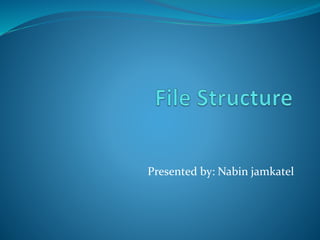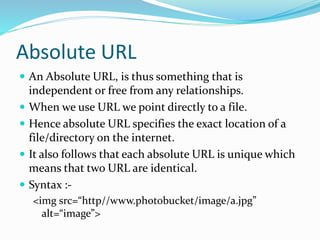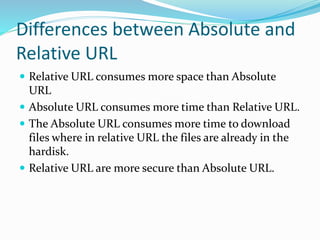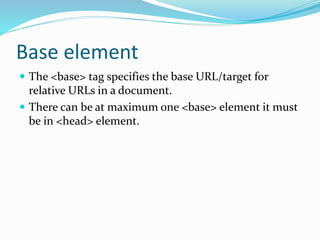File structure
- 1. Presented by: Nabin jamkatel
- 2. Absolute URL ? An Absolute URL, is thus something that is independent or free from any relationships. ? When we use URL we point directly to a file. ? Hence absolute URL specifies the exact location of a file/directory on the internet. ? It also follows that each absolute URL is unique which means that two URL are identical. ? Syntax :- <img src=/slideshow/file-structure-44787530/44787530/“http/www.photobucket/image/a.jpg” alt=“image”>
- 3. Relative URL ? An relative URL points to a file/ directory in relation to present file directory ? For example:- <img src=/slideshow/file-structure-44787530/44787530/“../image/asian.jpg” alt=“asian”> ../= one step back from the folder to be on the root.
- 5. Differences between Absolute and Relative URL ? Relative URL consumes more space than Absolute URL ? Absolute URL consumes more time than Relative URL. ? The Absolute URL consumes more time to download files where in relative URL the files are already in the hardisk. ? Relative URL are more secure than Absolute URL.
- 6. Base element ? The <base> tag specifies the base URL/target for relative URLs in a document. ? There can be at maximum one <base> element it must be in <head> element.
- 7. ? Syntax: <!DOCTYPE> <html> <base href=“http://www.nepal1.com/images/”> </head> <body> <img src=/slideshow/file-structure-44787530/44787530/“Nepalsbeauty.jpg” width=“100” height=“100” alt=“image”/> <a href=“www.asm.edu.np”>Asian link</a> </body> </html>







